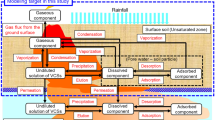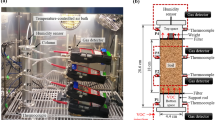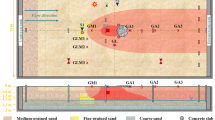Abstract
For the assessment of human health risks from soil contaminated by volatile chemical substances (VCSs), it is important to quantitatively estimate the volatilization fluxes that occur at the ground surface due to the upward transport of VCS components in unsaturated soil. The model constructed by the authors is based on the quantitative evaluation of advection–dispersion behavior associated with the volatilization of VCSs and allows detailed consideration of soil properties and the boundary conditions between the atmosphere-ground surface and unsaturated soil-aquifer compared to existing models. This study focuses on the evaluation of the effect of soil properties on the generation of volatilization flux through numerical analyses by changing the permeability characteristics of surface soil depending on the difference in soil particle size, porosity, and distribution coefficient between the water and soil phases, targeting benzene as a model substance of VCSs. A series of calculated results can be classified into cases dominated by either an increase of volatilization flux or transport to the aquifer, depending on soil properties, indicating the necessity of appropriate countermeasures for remediation and risk assessment. For the reduction of health risks derived from the generation of volatilization flux, removal of contaminants existing in the surface soil, including the ground surface, is essential. However, it is necessary to prevent the spread of contamination into the aquifer when the contaminants have high mobility in surface soil.
Similar content being viewed by others
Availability of Data and Materials
Not applicable.
Abbreviations
- \({C}_{\mathrm{s}}\) :
-
The amount of adsorption of benzene to the soil particles (mg/kg)
- \({C}_{\mathrm{w}}\) :
-
Dissolved concentration of benzene in water phase (mg/L)
- \({D}_{\mathrm{A}}\) :
-
Average grain diameter (m)
- \({D}_{\mathrm{A0}}\) :
-
Average grain diameter of Toyoura sand as a standard value (m)
- \({D}_{{\mathrm{g}},k}\) :
-
Dispersion coefficient of component k in gas phase (m2/s)
- \({D}_{{\mathrm{w}},k}\) :
-
Dispersion coefficient of component k in water phase (m2/s)
- \(g\) :
-
Gravity, (m/s2)
- \(K\) :
-
Absolute permeability, (m2)
- \({K}_{z}\) :
-
Absolute permeability for z-axis, (m2)
- \({K}_{{\mathrm{d}},k}\) :
-
Distribution coefficient between soil and water of component k, (m3/kg)
- \({K}_{\mathrm{ow},k}\) :
-
Octanol–water partition coefficient of component k, (m3/m3)
- \({k}_{\mathrm{rg}}\) :
-
Relative permeability to gas phase (dimensionless)
- \({k}_{\mathrm{rn}}\) :
-
Relative permeability to NAPL phase (dimensionless)
- \({k}_{\mathrm{rw}}\) :
-
Relative permeability to water (dimensionless)
- \({M}_{{\mathrm{c}},k}\) :
-
Molar mass of total benzene (kg/kmol)
- \({M}_{\mathrm{g}}\) :
-
Molar mass of gas phase of benzene (kg/kmol)
- \({M}_{\mathrm{n}}\) :
-
Molar mass of NAPL phase (undiluted solution) of benzene (kg/kmol)
- \({M}_{\mathrm{w}}\) :
-
Molar mass of water phase of benzene (kg/kmol)
- \(P\) :
-
System pressure (Pa)
- \({P}_{i,k}\) :
-
System pressure of component k at i block (Pa)
- \({P}_{\mathrm{c,gw}}\) :
-
Capillary pressure operating between gas and water phases (Pa)
- \({P}_{\mathrm{c,nw}}\) :
-
Capillary pressure operating between NAPL and water phases (Pa)
- \({P}_{\mathrm{g}}\) :
-
Pressure of gas phase (Pa)
- \({P}_{\mathrm{sat},k}\) :
-
Saturated vapor pressure of component k (Pa)
- \({R}_{\mathrm{vn}}\) :
-
Volatilization/condensation rate of NAPL phase (kmol/m3/s)
- \({R}_{\mathrm{vnc},k}\) :
-
Volatilization/condensation rate of component k in NAPL phase (kmol/m3/s)
- \({R}_{\mathrm{vs}}\) :
-
Volatilization rate derived from all of adsorption component (kmol/m3/s)
- \({R}_{\mathrm{vsc},k}\) :
-
Volatilization rate derived from each adsorption component (kmol/m3/s)
- \({R}_{\mathrm{vw}}\) :
-
Volatilization/condensation rate of water phase (kmol/m3/s)
- \({R}_{\mathrm{vwc},k}\) :
-
Volatilization/condensation rate of component k in water phase (kmol/m3/s)
- \({S}_{\mathrm{g}}\) :
-
Gas saturation (dimensionless)
- \({S}_{\mathrm{gr}}\) :
-
Residual gas saturation (dimensionless)
- \({S}_{\mathrm{lr}}\) :
-
Residual liquid saturation (dimensionless)
- \({S}_{\mathrm{n}}\) :
-
NAPL saturation (dimensionless)
- \({S}_{\mathrm{nr}}\) :
-
Residual NAPL saturation (dimensionless)
- \({S}_{\mathrm{w}}\) :
-
Water saturation (dimensionless)
- \({S}_{\mathrm{wi}}\) :
-
Irreducible water saturation (dimensionless)
- \({S}_{\mathrm{wi}0}\) :
-
Irreducible water saturation obtained for Toyoura sand as a standard value (dimensionless)
- \(t\) :
-
Time (s)
- \({w}_{{\mathrm{g}},k}\) :
-
Molar fraction of component k in gas phase (dimensionless)
- \({x}_{{\mathrm{w}},k}\) :
-
Molar fraction of component k in water phase (dimensionless)
- \({x}_{{\mathrm{s}},k}\) :
-
Adsorption concentration of component k (kmol/kg)
- \({x}_{\mathrm{s,sat}, k}\) :
-
Saturated adsorption of component k (kmol/kg)
- \(\Delta x\) :
-
Block length in x-direction (m)
- \({y}_{{\mathrm{n}},k}\) :
-
Molar fraction of component k in NAPL phase (dimensionless)
- \({y}_{{\mathrm{l}},k}\) :
-
Molar fraction of component k in liquid phase (dimensionless)
- \(\Delta y\) :
-
Block length in y-direction (m)
- \(\Delta z\) :
-
Block length in z-direction (m)
- \({\mu }_{\mathrm{g}}\) :
-
Viscosity of gas phase (Pa⋅s)
- \({\mu }_{\mathrm{n}}\) :
-
Viscosity of NAPL phase (Pa⋅s)
- \({\mu }_{\mathrm{w}}\) :
-
Viscosity of water phase (Pa⋅s)
- \({\mu }_{{\mathrm{w}},15^\circ \mathrm{C}}\) :
-
Viscosity of water phase at 15 °C (Pa⋅s)
- \({\rho }_{\mathrm{g}}\) :
-
Mole weight of gas phase (kmol/m3)
- \({\rho }_{\mathrm{n}}\) :
-
Mole weight of NAPL phase (kmol/m3)
- \({\rho }_{\mathrm{s}}\) :
-
Density of soil particle (kg/m3)
- \({\rho }_{\mathrm{w}}\) :
-
Mole weight of water phase (kmol/m3)
- \({\Phi }_{\mathrm{g}}\) :
-
Flow potential of gas phase (Pa)
- \({\Phi }_{\mathrm{n}}\) :
-
Flow potential of NAPL phase (Pa)
- \({\Phi }_{\mathrm{w}}\) :
-
Flow potential of water phase (Pa)
- \(\phi\) :
-
Porosity (dimensionless)
References
Komai, T., Kawabe, Y., Hara, J., Sakamoto, Y., & Sugita, H. (2009). Development of a risk assessment system for soil contamination and the application to the social system. Synthesiology - English edition., 1(4), 251–262. https://doi.org/10.5571/syntheng.1.251
Rathfelder, K., Yeh, W.W.-G., & Mackay, D. (1991). Mathematical simulation of soil vapor extraction systems: Model development and numerical examples. Journal of Contaminant Hydrology., 8(3), 263–297. https://doi.org/10.1016/0169-7722(91)90023-T
Voudrias, E., & Li, C. (1993). Benzene vapor transport in unsaturated soil: Adequacy of the diffusion equation. Journal of Hazardous Materials., 34, 295–311. https://doi.org/10.1016/0304-3894(93)85096-W
Werth, C. J., & Hansen, K. M. (2002). Modeling the effects of concentration history on the slow desorption of trichloroethene from a soil at 100% relative humidity. Journal of Contaminant Hydrology., 54, 307–327. https://doi.org/10.1016/S0169-7722(01)00183-8
Karapanagioti, H. K., Gaganis, P., Burganos, V. N., & Höhener, P. (2004). Reactive transport of volatile organic compound mixtures in the unsaturated zone: Modeling and tuning with lysimeter data. Environmental Modelling & Software., 19, 435–450. https://doi.org/10.1016/S1364-8152(03)00159-2
Cotel, S., Schaefer, G., Barthes, V., & Baussand, P. (2011). Effect of density-driven advection on trichloroethylene vapor diffusion in a porous medium. Vadose Zone Journal., 10(2), 565–581. https://doi.org/10.2136/vzj2010.0032
Nobre, M. M. M., & Nobre, R. C. M. (2004). Soil vapor extraction of chlorinated solvents at an industrial site in Brazil. Journal of Hazardous Materials., 110, 119–127. https://doi.org/10.1016/j.jhazmat.2004.02.045
Abreu, L. D. V., & Johnson, P. C. (2005). Effect of vapor source - building separation and building construction on soil vapor intrusion as studied with a three-dimensional numerical model. Environmental Science & Technology., 39, 4550–4561. https://doi.org/10.1021/es049781k
Abreu, L. D. V., & Johnson, P. C. (2006). Simulating the effect of aerobic biodegradation on soil vapor intrusion into buildings: Influence of degradation rate, source concentration, and depth. Environmental Science & Technology., 40, 2304–2315. https://doi.org/10.1021/es051335p
Høier, C. K., Sonnenborg, T. O., Jensen, K. H., & Gudbjerg, J. (2008). Model analysis of mechanisms controlling pneumatic soil vapor extraction. Journal of Contaminant Hydrology., 103(3–4), 82–98. https://doi.org/10.1016/j.jconhyd.2008.09.008
Abreu, L. D. V., Ettinger, R., & McAlary, T. (2009). Simulated soil vapor intrusion attenuation factors including biodegradation for petroleum hydrocarbons. Groundwater Monitoring & Remediation., 29, 105–117. https://doi.org/10.1111/j.1745-6592.2008.01219.x
Wang, X., Unger, A. J., & Parker, B. L. (2012). Simulating an exclusion zone for vapor intrusion of TCE from groundwater into indoor air. Journal of Contaminant Hydrology., 140–141, 124–138. https://doi.org/10.1016/j.jconhyd.2012.07.004
Ma, J., Xiong, D., Li, H., Ding, Y., Xia, X., & Yang, Y. (2017). Vapor intrusion risk of fuel ether oxygenates methyl tert-butyl ether (MTBE), tert-amyl methyl ether (TAME) and ethyl tert-butyl ether (ETBE): A modeling study. Journal of Hazardous Materials., 332, 10–18. https://doi.org/10.1016/j.jhazmat.2017.02.057
Yang, Y., Li, J., Xi, B., Wang, Y., Tang, J., Wang, Y., & Zhao, C. (2017). Modeling BTEX migration with soil vapor extraction remediation under low-temperature conditions. Journal of Environmental Management., 203, 114–122. https://doi.org/10.1016/j.jenvman.2017.07.068
Yao, Y., Mao, F., Xiao, Y., & Luo, J. (2019). Modeling capillary fringe effect on petroleum vapor intrusion from groundwater contamination. Water Research., 150, 111–119. https://doi.org/10.1016/j.watres.2018.11.038
Kondo, M., Sakamoto, Y., Kawabe, Y., et al. (2022). Development of a model for predicting the volatilization flux from unsaturated soil contaminated by volatile chemical substances. Environmental Modeling and Assessment, 27, 251–273. https://doi.org/10.1007/s10666-021-09796-0
Japan Meteorological Agency. https://www.data.jma.go.jp/obd/stats/etrn/index.php
The Japanese Geotechnical Society. (2001). ISBN: 4–88644–062–2, pp.0–251 (Japanese only)
Matsuo, S. & Kogure, K. (1969). 560. A study on soil permeability. The Japanese Geotechnical Society, 17(5), 23–29.
Sakamoto, Y., Komai, T., Kawamura, T., Minagawa, H., Tenma, N., & Yamaguchi, T. (2007). Laboratory-scale experiment of methane hydrate dissociation by hot-water injection and numerical analysis for permeability estimation in reservoir: Part 1-numerical study for estimation of permeability in methane hydrate reservoir. International Journal of Offshore and Polar Engineering., 17, 47–56.
Sakamoto, Y., Nishiwaki, J., Hara, J., Kawabe, J., Sugai, Y. & Komai, T. (2011). Development of multi-phase and multi-component flow model with reaction in porous media for risk assessment on soil contamination due to mineral oil. Journal of Japan Society of Civil Engineers, Ser. G (Environmental Research), 67(2), 78–92. https://doi.org/10.2208/jscejer.67.78
Gustafson, J., & Tell, J. G. (1997). Total petroleum hydrocarbon criteria working group series volume 3, selection of representative TPH fractions based on fate and transport considerations.
Acknowledgements
This study was conducted as part of an international joint research program programmed at the GP-RSS, Tohoku University, Japan.
Funding
The present study was supported by Japan Society for the Promotion of Science (JSPS) grants 23KJ0120. This research was performed by the Environment Research and Technology Development Fund, grant number 5–1905 (JPMEERF20195005), of the Environmental Restoration and Conservation Agency provided by the Ministry of Environment of Japan. And it was also supported by JST SPRING, Grant Number JPMJSP2114.
Author information
Authors and Affiliations
Contributions
All authors contributed to the study conception and design. Model simulations were carried out by Y.S. The first draft of the manuscript was written by M.K. and Y.S., and all authors commented on previous versions of the manuscript. All authors read and approved the final manuscript.
Corresponding author
Ethics declarations
Ethical Approval
Not applicable.
Competing interests
The authors declare no competing interests.
Additional information
Publisher's Note
Springer Nature remains neutral with regard to jurisdictional claims in published maps and institutional affiliations.
Appendix A
Appendix A
Changes in distributions of total petroleum hydrocarbon (TPH) (mg/kg), NAPL saturation, \({S}_{n}\) (-), dissolved concentration of benzene in the water phase, \({C}_{w}\) (mg/L), and amount of adsorption of benzene on soil particles, \({C}_{w}\) (mg/kg), in the vertical direction over time for reference calculation conditions
Correlations between absolute permeability in surface soil and porosity at the ground surface to the generation of volatilization flux of benzene (VFB), overlaying with residual ratio of TPH and average gas saturation at the ground surface and contribution ratio of advection to total volatilization flux
Rights and permissions
Springer Nature or its licensor (e.g. a society or other partner) holds exclusive rights to this article under a publishing agreement with the author(s) or other rightsholder(s); author self-archiving of the accepted manuscript version of this article is solely governed by the terms of such publishing agreement and applicable law.
About this article
Cite this article
Kondo, M., Sakamoto, Y., Kawabe, Y. et al. Numerical Analysis on the Effect of Soil Properties on the Generation of Volatilization Flux from Unsaturated Soil Contaminated by Volatile Chemical Substances. Environ Model Assess 28, 1055–1081 (2023). https://doi.org/10.1007/s10666-023-09914-0
Received:
Accepted:
Published:
Issue Date:
DOI: https://doi.org/10.1007/s10666-023-09914-0


























